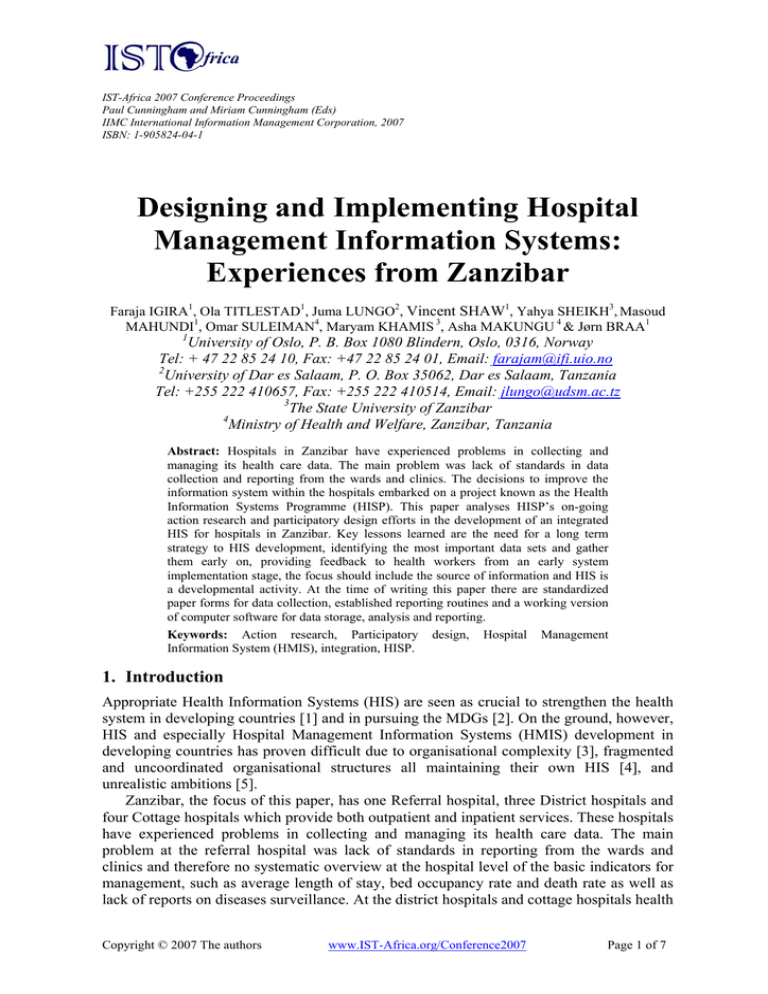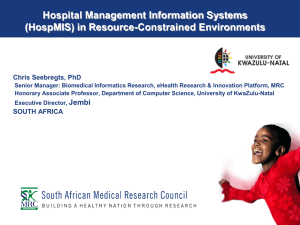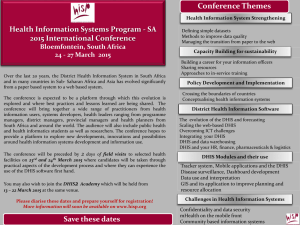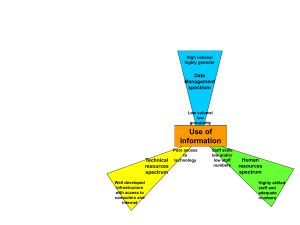Document 11592591
advertisement

IST-Africa 2007 Conference Proceedings Paul Cunningham and Miriam Cunningham (Eds) IIMC International Information Management Corporation, 2007 ISBN: 1-905824-04-1 Designing and Implementing Hospital Management Information Systems: Experiences from Zanzibar Faraja IGIRA1, Ola TITLESTAD1, Juma LUNGO2, Vincent SHAW1, Yahya SHEIKH3, Masoud MAHUNDI1, Omar SULEIMAN4, Maryam KHAMIS 3, Asha MAKUNGU 4 & Jørn BRAA1 1 University of Oslo, P. B. Box 1080 Blindern, Oslo, 0316, Norway Tel: + 47 22 85 24 10, Fax: +47 22 85 24 01, Email: farajam@ifi.uio.no 2 University of Dar es Salaam, P. O. Box 35062, Dar es Salaam, Tanzania Tel: +255 222 410657, Fax: +255 222 410514, Email: jlungo@udsm.ac.tz 3 The State University of Zanzibar 4 Ministry of Health and Welfare, Zanzibar, Tanzania Abstract: Hospitals in Zanzibar have experienced problems in collecting and managing its health care data. The main problem was lack of standards in data collection and reporting from the wards and clinics. The decisions to improve the information system within the hospitals embarked on a project known as the Health Information Systems Programme (HISP). This paper analyses HISP’s on-going action research and participatory design efforts in the development of an integrated HIS for hospitals in Zanzibar. Key lessons learned are the need for a long term strategy to HIS development, identifying the most important data sets and gather them early on, providing feedback to health workers from an early system implementation stage, the focus should include the source of information and HIS is a developmental activity. At the time of writing this paper there are standardized paper forms for data collection, established reporting routines and a working version of computer software for data storage, analysis and reporting. Keywords: Action research, Participatory design, Hospital Management Information System (HMIS), integration, HISP. 1. Introduction Appropriate Health Information Systems (HIS) are seen as crucial to strengthen the health system in developing countries [1] and in pursuing the MDGs [2]. On the ground, however, HIS and especially Hospital Management Information Systems (HMIS) development in developing countries has proven difficult due to organisational complexity [3], fragmented and uncoordinated organisational structures all maintaining their own HIS [4], and unrealistic ambitions [5]. Zanzibar, the focus of this paper, has one Referral hospital, three District hospitals and four Cottage hospitals which provide both outpatient and inpatient services. These hospitals have experienced problems in collecting and managing its health care data. The main problem at the referral hospital was lack of standards in reporting from the wards and clinics and therefore no systematic overview at the hospital level of the basic indicators for management, such as average length of stay, bed occupancy rate and death rate as well as lack of reports on diseases surveillance. At the district hospitals and cottage hospitals health Copyright © 2007 The authors www.IST-Africa.org/Conference2007 Page 1 of 7 workers collect daily inpatient and outpatient data using hand drawn register books with no system of reporting and therefore data is stored in the respective registers within the respective ward or clinic. The health care services delivery systems in Zanzibar can be summarized in Figure 1. Figure 1: Health care delivery system in Zanzibar Given the resources situation in Tanzania-Zanzibar and in Africa in general, it is important to find a simple, inexpensive but an efficient and effective way for hospital data management and use. In November 2004, the Ministry of Health and Social Welfare in Zanzibar decided to improve the information system within the hospitals (referral hospital, district hospitals and cottage hospital). The decisions embarked on the HISP project, which is also contracted to improve the health management information system in Zanzibar as a whole (i.e. data collection, information flows and use between various health care administrative levels – community, health facilities, districts, zones and national levels). The rest of this paper is structured as follows. Section 2 provides the core objectives underlying the development of HMIS in Zanzibar. Section 3 describes the methodology used. Section 4 describes the HMIS development process. Section 5 outlines the results of the development process in terms of the system developed and potential impacts to date and lastly the concluding remarks and implications are summarized in section 6. 2. Objectives The decisions to improve the HMIS lead to the establishment of the following development and implementation objectives: 1. Identifying standard datasets for the hospital starting with datasets for each ward and clinic. 2. Establishing standardized data collection and reporting tools as well as reporting routines. 3. Customising the DHIS to meet the hospital’s information requirements 4. Extensive training of users. The objectives of this paper is to present HISP experiences in Zanzibar so far basing on the development and implementation process, the challenges encountered, the results and potential impacts to date and key lessons learnt. 3. Methodology: Action Research, Participatory Design and HISP This study is based on Action research and Participatory design approaches in systems development and implementation. While some of the authors make up the HISP’s developer team (local and international), others are among health workers within the Copyright © 2007 The authors www.IST-Africa.org/Conference2007 Page 2 of 7 hospitals in Zanzibar who took part in the development and implementation process. The action research and participatory approaches used by HISP in Zanzibar and HISP in other countries more generally draws on the Scandinavian tradition where the first projects aimed at empowering workers and their participating unions [7]. In using participatory design approach people designated to use the system play a crucial role in designing it [13][14][15]. The participatory design and action research applied by HISP in Zanzibar is particularly targeted at involving health workers in the designing of routine hospital HIS, which collects, analyses and report aggregated (statistical) data on most health care activities within the hospitals. In this system there are fragmentation between different health programs and services leading to overlaps, gaps and lack of standard definitions for data elements and indicators. As a result of all these factors, the HISs are in general not meeting the basic information needs of health services management at the ward and clinic level, the hospital level as well as the national level. On the one hand, experience from the HISP network has revealed a number of problems and challenges in following participatory approaches in the design and implementation of HISs in developing countries [6][8][9][12]. Such problems include the need for integrating multiple levels and programs with different needs and plans at the same time follow the national and international standards [6][8][10]. Furthermore, it has proven to be difficult to apply participatory approaches in a centralized and politically controlled organizational setting like what happened during the HISP work in Cuba [9]. However, development of more sophisticated health information systems has proven to be difficult both in developed and developing countries, and a large number of failures are reported [3][11]. On the other hand the need in the health sector to involve multiple levels and to scale up to cover large areas involves multiple communities of practice and many organizational units or workplaces [6]. This poses a challenge to the “traditional” participatory design techniques that are emphasizing intense interaction with a restricted number of users. In South Africa this problem was addressed by an informal ‘activist’ oriented prototyping strategy [8]. 4. Developments: Participatory process of defining the HIS The HMIS design and implementation process started in June 2005 and still ongoing. The process started with Mnazi Mmoja referral hospital and then scaled down to the district and cottage hospitals. Due to space limitations this paper reports on the HMIS design and implementation at Mnazi Mmoja hospital. However, it is important to note that experience and key lessons learnt from Mnazi Mmoja played a crucial role during the scaling down process. Practicing user participation, the design process started by identifying health workers (users) from Mnazi Mmoja hospital to work with the designers’ team. The users’ team consisted of the head of the statistics department and one doctor who is also the assistant head of the hospital. Furthermore the in-charges from different wards and clinics played a major role throughout the design and implementation process. The following is a description of the development and implementation process 4.1 Identifying standard datasets and establishing standardized data collection and reporting tools In agreeing and establishing a standardized reporting format a meeting was conducted with in-charges from the wards whereby they were informed about the task at hand and asked to write the suggested data elements (these are mainly diagnosis) with regard to health care Copyright © 2007 The authors www.IST-Africa.org/Conference2007 Page 3 of 7 services they provide. Then a group discussion was conducted to discuss the data elements identified as well as the structure of the data collection forms. The data collection forms were put in use for one month and then a group discussion between the in-charges and the designers was conducted to review the forms as there were additional data elements as well as some data elements to be eliminated from the forms. After the first review of the forms, we started to customize the DHIS software to include the identified data elements. 4.2 Customising the DHIS to meet the hospital’s information requirements While the in-charges of each ward participated in defining their own data collection forms, the designers customised the DHIS software so that the data reported by more than one ward or clinic was standardised and made “integratable”. The most important data for the hospital management to integrate was the through-put data from the wards. Each ward reports the total monthly numbers on admissions, discharges, deaths and laying days through their own form. In the DHIS this through-put data was defined as data elements and was assigned to multiple forms so that all the forms from the wards used the same standardised data elements. Even though this means that the same data element names will be used by multiple forms, the name of the ward reporting the particular form makes the “data values” unique. To integrate information from various data sources and to provide flexibility to meet the rapidly changing requirements of the health care domain, the DHIS design strategy is based on a more flexible model that goes beyond the typical “computerise the forms”-approach. Instead of computerising the form, the DHIS is computerising every data item or data element in the form independently. By breaking up the form into more fine-grained building blocks of data the software also breaks up the fragmentation represented by the forms and provides the possibility of manipulating and presenting data across health programs. This is a prerequisite for integrated data analysis. This design enables the user to define custom reports, tables and graphs for analysis and can as well be understood as userdefined assemblies or reconstructions of the data (elements) that was captured using the forms. Furthermore, the DHIS allows for indicators to be defined as formulas based on the data elements. For example, the indicator “average length of stay” was defined as a formula of “Total admissions / (Total discharges + Total deaths)”. The indicators “Bed occupancy rate” (bed capacity was also collected as a data element in the system) and “death rate” were defined in a similar manner using the standardised data elements. Given these defined standard data and indicator sets, reports could then be generated providing through-put information for the hospital as a whole or as comparisons of the wards. 4.3 Extensive training of users The implementation of the HMIS within the hospital was done in parallel with training the in-charges of wards and clinics on how to fill in the new designed paper forms. After the first month of testing and reviewing we had to conduct another training. Due to lack of computer resources as well as the distribution of work among the health workers at the hospital, not all health workers were trained in how to use the DHIS. Only the health workers who work at the hospital’s Statistics department (responsible for compiling all the reports from the wards and clinics) were trained. The DHIS training had to start with basics of using computers such as how to move a mouse since most health workers had never used a computer. Furthermore, two health workers from the hospital were involved in an extended course in HMIS at the University of Dar es Salaam Tanzania, which also includes practical Copyright © 2007 The authors www.IST-Africa.org/Conference2007 Page 4 of 7 exercises on using the DHIS. The combination of on-site training and the HMIS course had been instrumental in creating a shared understanding and general knowledge about key principles related to HMIS. 5. Results At the time of writing this paper there are standardized data collection and reporting tools consisting of essential datasets for each ward and clinic. Reporting routines have been established whereby health workers collect data routinely in the register books and report monthly. There is also a working version of the DHIS being used for data analysis and data storage. Therefore, the reported data from the wards and clinics is entered in the DHIS where analysis and, monthly, quarterly and yearly aggregates can be done. Recent developments on working with the 2006 annual reports for the hospital have shown some signs of change. The fact that annual reports must be delivered has opened up for some time and place for the software to be used and more training sessions to be organized at the management level. Through generating these important reports in far more advanced ways and more efficiently than previous year’s manual work seem to open up the eyes of the management. The fact that most health workers were computer illiterate, the use of DHIS has opened possibilities and motivation for health workers to learn how to use computers. Furthermore network and Internet facilities have been established between the hospital and the Ministry of health so as to facilitate the data reporting and transmission process. An additional advantage with this network and Internet is that health workers at the hospital can communicate within the hospital as well as with the Ministry of Health through Skype. On the one had these developments have created jobs within the Ministry of health since they had to employ computer experts to help in maintaining the network. On the other hand local Internet Service Providers also got contract for running the Internet services. 6. Challenges and Key lessons During the design and implementation of HMIS in hospitals in Zanzibar several challenges and obstacles to the proposed approach were encountered, some of the most significant are outlined in this section. While the approach followed was of the start simple and grow as you learn kind, the managers and in-charges of the hospital insisted on the need for fully coverage of their daily activities. As a result every month health workers added more diagnosis (data elements) to the initially agreed-upon data collection forms. While these changes were technically manageable by the flexible software, increasing the amount of data to be collected meant decreasing the quality at the same time. Despite the involvement in expanding the data collection forms, the busy schedule of health workers made it difficult for them to participate fully in the design process. For example, it was not possible to have all the in-charges from the wards and clinics every time group discussions were conducted. Sometimes we had to follow the individual incharges in their respective wards and clinics while they were attending patients, to have their comments and suggestions about the designed reporting forms. Although computers are being used for different activities in organizations in developing countries, the majority of people are still computer illiterate [12]. While the training in DHIS use was sufficient to master data entry, the more advanced data analysis functionalities are still difficult to master for the statisticians. This has been one of the factors contributing to the so far limited use of the information collected in the Copyright © 2007 The authors www.IST-Africa.org/Conference2007 Page 5 of 7 computerised HIS. The design process focused on the monthly aggregated forms that is reported from the wards to the statistics unit, and did not include the source of information; the daily register books in the wards being used for daily recording of patients’ admissions, discharges, deaths and lying days. While the monthly forms followed a standardised design the register books were hand drawn and followed different designs from ward to ward. As a result the numbers reported from the wards in the monthly forms, especially on laying days, were incorrect and inconsistent. This was an important lesson learnt that focus must be put on the very source of information, even though that level is not computerised. Standardisation of the register books and training in how to fill in the forms and how to calculate the aggregated values are necessary steps that must be taken before the computerised system can provide quality data. Despite the fact that the computerised system did not “stop” the incorrect data, the generated reports with indicator values (the bed occupancy rate in this case) and graphs made it easier to spot incorrect values and to track the source of the problem. To date the most challenging task that remains to overcome is to establish routines for active use of information to support decision-making at the hospital. Establishing an information culture is a long-term process and it must start with small steps. One major obstacle met when taking those first important steps was the lack of understanding on how a computerised HIS works and how it can support management. The understanding of data as in the traditional way of collecting and reporting data using forms goes deep and is hard to change. The DHIS allows for the manager to freely design reports, tables and graphs with the desired data elements and indicators completely independent of the forms used for collection, and this is often necessary to get integrated reports for the hospital. Making use of this flexible and powerful data analysis tool requires a mutual learning process where the designer or technical experts and the hospital managers work together on the data analysis. This step cannot be taken alone by neither the technician with lack of hospital managerial skills or by the hospital manger lacking an understanding of what the software can do to support her. 7. Conclusions While the flexible nature of the software and the philosophy of the designers are encouraging user-participation and increased use of information at all levels, this approach must be seen as a long term learning process where progress is made in small steps along the way. Furthermore, the appropriate use of the system demands extensive training. The HIS should be seen as a developmental activity whereby health workers need to gradually adapt the working routines through the developed HIS and take advantage of the new system to improve management and ultimately the health care services. Despite the challenges encountered, the development and implementation process have shown some signs of change and achievements of the set objectives. The fact that there is standardized data collection and reporting forms has lead to possible integration of data from the different wards and clinics within the hospital. Furthermore, the use of the DHIS software has been a source for health workers to learn how to use computers and helped in the analysis of data and thus point out to problems in the collected data as well as the general performance of the hospital. References [1] WHO. Design and implementation of health information systems, World Health Organisation, Geneva, 2000. Copyright © 2007 The authors www.IST-Africa.org/Conference2007 Page 6 of 7 [2] [3] [4] [5] [6] [7] [8] [9] [10] [11] [12] [13] [14] [15] [16] AbouZahr, C., and Boerma, T. Health information systems: the foundations of public health, Bulletin of the World Health Organisation (83:8), 2005, pp. 578-583. Littlejohns, P., Wyatt, J. C., and Garvican, L. Evaluating computerised health information systems: hard lessons still to be learnt, British Medical Journal (326), April 2003, pp. 860-863. Chilundo, B., and Aanestad, M. Negotiating Multiple Rationalities in the Process of Integrating the Information Systems of Disease-Specific Health Porgrammes, 2004. Heeks, R. Failure, Success and Improvisation of Information Systems Projects in Developing Countries, 2002. Braa J, Monteiro E. and Sahay S. Networks of action: sustainable health information systems across developing countries. MIS Quarterly. 2003. Bjerknes G. and Bratteteig T. User Participation and Democracy: A Discussion of Scandinavian Research on System Development. 1995. Braa J. and Hedberg C. The Struggle for developing District Health Information Systems in South Africa. 2002. Braa J, Titlestad H O, Sæbø J. Participatory health information systems development in Cuba – the challenge of addressing multiple levels in a centralized setting. Lippeveld, T. and Sauerborn, R. A framework for designing health information systems. In Lippeveld, T. et al.: Design and implementation of health information systems. WHO, Geneva 2000. Heeks R, Mundy D. and Salazar A. Why Health Care Information Systems Succeed or Fail. 1999 Kimaro H C, Titlestad O H. Challenges of user participation in the design of a computer based system: The possibility of participatory customisation in low-income countries. Abuja 2005. Bjerknes, G. and Bratteteig, T. Florence in Wonderland: Systems Development with Nurses, In Computers and Democracy, G. Bjerknes, P. Ehn, and M. Knyg (Eds.) Avebury, England, 1987, pp. 279296. Ehn, P. Work-Oriented Design of Computer Artifacts. Almquist and Wiksell International Pub., Stockholm, Sweden, 1988. Schuler. D., and Namioka, A., EDs. Participatory Design: Principlesand Practice. Erlbaum, Hillsdale, N.J., 1993 Blomberg, J. and Henderson, A. (1990). Reflections on participatory design: Lessons from the trillium experience. In CHI '90 Human Factors in Computing Systems, pages 353-359. ACM, Seattle, Washington. Copyright © 2007 The authors www.IST-Africa.org/Conference2007 Page 7 of 7






